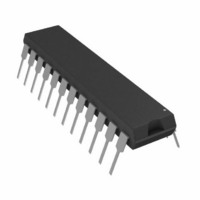AD7880BNZ Analog Devices Inc, AD7880BNZ Datasheet - Page 8

AD7880BNZ
Manufacturer Part Number
AD7880BNZ
Description
IC ADC 12BIT MONO LOW PWR 24DIP
Manufacturer
Analog Devices Inc
Datasheet
1.AD7880BRZ-REEL.pdf
(16 pages)
Specifications of AD7880BNZ
Data Interface
Parallel
Operating Temperature
-40°C ~ 85°C
Number Of Bits
12
Sampling Rate (per Second)
66k
Number Of Converters
1
Power Dissipation (max)
50mW
Voltage Supply Source
Single Supply
Mounting Type
Through Hole
Package / Case
24-DIP (0.300", 7.62mm)
Resolution (bits)
12bit
Input Channel Type
Single Ended
Supply Voltage Range - Analogue
4.75V To 5.25V
Supply Current
10mA
No. Of Pins
24
Sampling Rate
66kSPS
Rohs Compliant
Yes
Lead Free Status / RoHS Status
Lead free / RoHS Compliant
Available stocks
Company
Part Number
Manufacturer
Quantity
Price
AD7880
Total Harmonic Distortion (THD)
THD is the ratio of the rms sum of harmonics to the rms value
of the fundamental. For the AD7880, THD is defined as:
where V
V
sixth harmonic. The THD is also derived from the FFT plot of
the ADC output spectrum.
Intermodulation Distortion
With inputs consisting of sine waves at two frequencies, fa and
fb, any active device with nonlinearities will create distortion
products at sum and difference frequencies of mfa
m, n = 0, 1, 2, 3, etc. Intermodulation terms are those for which
neither m nor n are equal to zero. For example, the second or-
der terms include (fa + fb) and (fa – fb), while the third order
terms include (2fa + fb), (2fa – fb), (fa + 2fb) and (fa – 2fb).
4
, V
10.5
11.5
Figure 13. Effective Number of Bits vs. Frequency
THD
12
5
10
11
and V
1
is the rms amplitude of the fundamental and V
6
20 log
are the rms amplitudes of the second through the
V
2
INPUT FREQUENCY – kHz
2
V
3
2
15
V
V
1
SAMPLE FREQUENCY = 61kHz
T = 25 C
4
A
2
V
5
2
V
6
2
nfb where
2
, V
30.5
3
,
(3)
–8–
Using the CCIF standard where two input frequencies near the
top end of the input bandwidth are used, the second and third
order terms are of different significance. The second order terms
are usually distanced in frequency from the original sine waves,
while the third order terms are usually at a frequency close to
the input frequencies. As a result, the second and third order
terms are specified separately. The calculation of the inter-
modulation distortion is as per the THD specification where it is
the ratio of the rms sum of the individual distortion products to
the rms amplitude of the fundamental expressed in dBs. In this
case, the input consists of two, equal amplitude, low distortion,
sine waves. Figure 14 shows a typical IMD plot for the
AD7880.
Peak Harmonic or Spurious Noise
Peak harmonic or spurious noise is defined as the ratio of the
rms value of the next largest component in the ADC output
spectrum (up to FS/2 and excluding dc) to the rms value of the
fundamental. Normally, the value of this specification will be
determined by the largest harmonic in the spectrum, but for
parts where the harmonics are buried in the noise floor the peak
will be a noise peak.
Figure 14. IMD Plot
REV. 0













